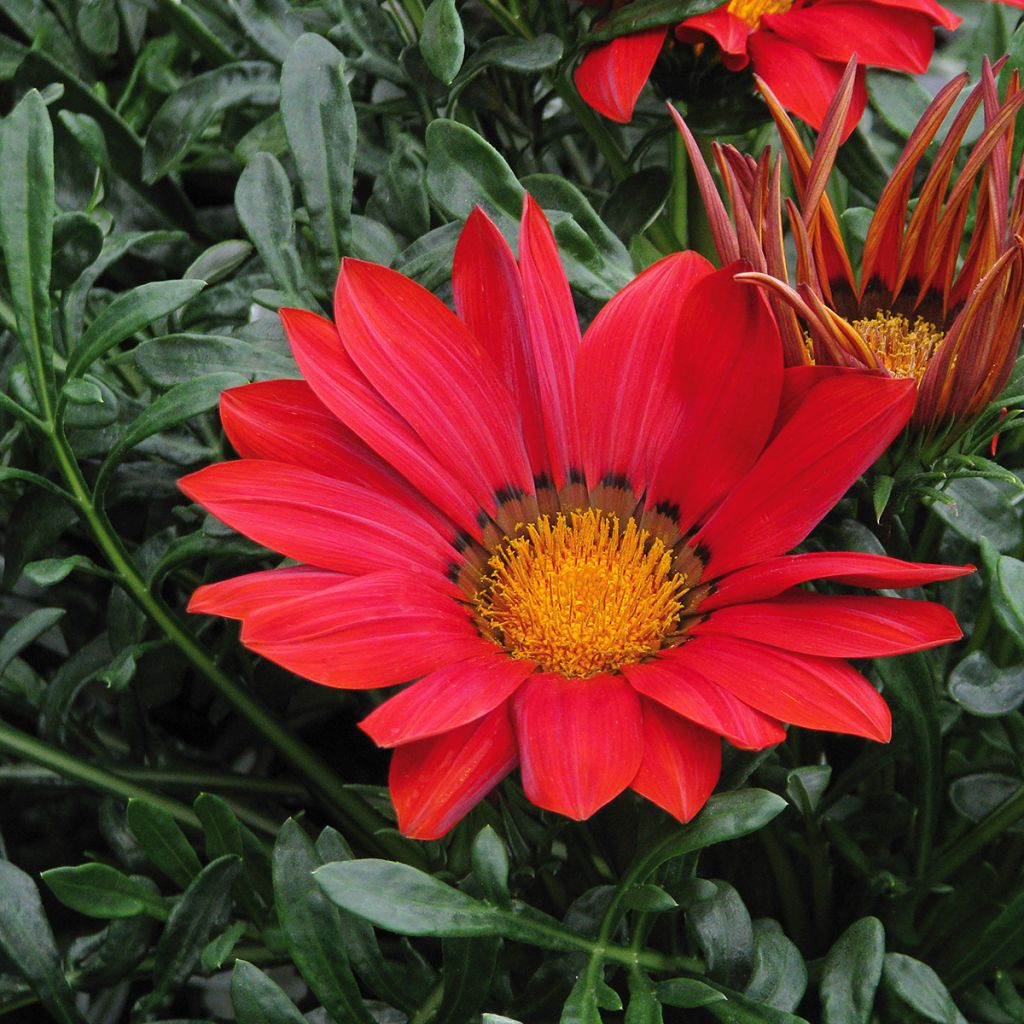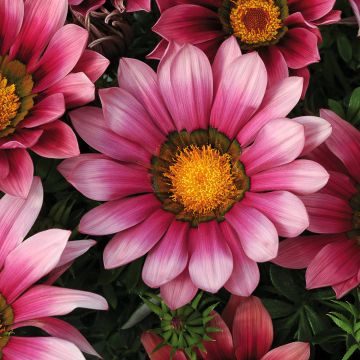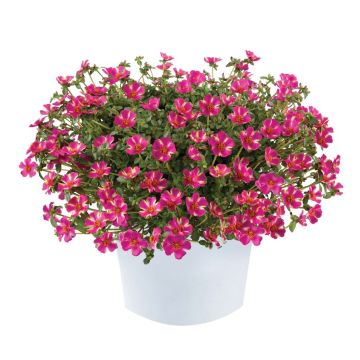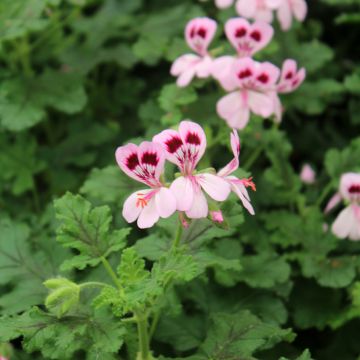

Gazania New Day Red Shades
Gazania rigens New Day Red Shades - Treasure flower
Gazania rigens New Day Red Shades
Treasure flower
This item cannot be shipped to the selected country
Delivery charge from €5.90
More information
Schedule delivery date,
and select date in basket
This plant carries a 6 months recovery warranty
More information
We guarantee the quality of our plants for a full growing cycle, and will replace at our expense any plant that fails to recover under normal climatic and planting conditions.
From €5.90 for pickup delivery and €6.90 for home delivery
Express home delivery from €8.90.
Does this plant fit my garden?
Set up your Plantfit profile →
Description
Gazania 'New Day Red Shades' is part of a series of gazanias selected for their compact habit, drought tolerance, and larger daisy-like flowers with more uniform colours. The flowers of this variety display shades of red and then orange. This tender perennial is usually grown as an annual. Gazanias, which have fallen out of fashion, are exceptional for their long-lasting and strikingly beautiful flowering. They are excellent flowers for hanging baskets, containers, rock gardens, and dry banks.
Gazania rigens, also known as treasure flower, belongs to the Asteraceae family. It is found throughout tropical and southern Africa. It is a fast-growing perennial, cultivated as an annual in Europe. The 'New Day Red Shades' cultivar forms a low, well-branched, and neat mound, about 20 to 25cm (8 to 10in) in all directions. The plant forms a tight cluster of non-lobed, leathery leaves that are medium green on top with a greyer underside. From May to October, it produces short stems, each carrying a solitary and terminal inflorescence called a head. Each head has a double row of alternate ligulate florets, which are initially red before turning orange. At the base of each ligule, a small rusty-brown motif bordered in black is visible. The small, tubular florets give a velvety appearance to the central yellow-orange disk. Note that gazania flowers only open in full sun.
Gazania 'New Day Red Shades' can be scattered in small patches, along well-drained borders or on a sunny bank, combined with taller, monochrome plants such as small grasses (stipa, carex), garden marigolds, nepetas, or dusty millers. They enhance the beauty of dry banks by accentuating their contours. Likewise, they are perfect in containers or flower beds that adorn a patio. Beginner or busy gardeners will appreciate them for both their beauty and simplicity. They are not demanding regarding soil conditions, as long as the soil is well-drained, and they can withstand long periods of drought. However, their flowering will decline if water is scarce.
Please be aware that our young plug plants are professional products intended for experienced gardeners. Upon receipt, repot and store them under cover (veranda, greenhouse, cold frame) at a temperature above 14°C (57.2°F) for a few weeks before planting them outdoors, once the risk of frost has definitely passed.
Report an error about the product description
Gazania rigens New Day Red Shades - Treasure flower in pictures


Flowering
Foliage
Plant habit
Botanical data
Gazania
rigens
New Day Red Shades
Asteraceae
Treasure flower
Cultivar or hybrid
Other Gazania
Planting and care
Gazanias are resilient plants that self-seed easily in the most unexpected places, including gravel paths or areas covered in limestone. They tolerate intense heat, drought, and poor soils. In summer, even light rain during extended drought will restart flowering. Plant them in well-drained, rocky or sandy soil, in full sun. These plants do not tolerate stagnant water. In warm climates, they can withstand temperatures as low as -6°C (21.2°F) for a short period when planted on a sunny bank in lightened soil. In cooler climates, the plants should be grown as annuals in open ground or in pots that can be stored indoors during winter in a bright and cool room, to keep them for several years.
Planting period
Intended location
Care
This item has not been reviewed yet - be the first to leave a review about it.
Plug plants - Annuals
Haven't found what you were looking for?
Hardiness is the lowest winter temperature a plant can endure without suffering serious damage or even dying. However, hardiness is affected by location (a sheltered area, such as a patio), protection (winter cover) and soil type (hardiness is improved by well-drained soil).

Photo Sharing Terms & Conditions
In order to encourage gardeners to interact and share their experiences, Promesse de fleurs offers various media enabling content to be uploaded onto its Site - in particular via the ‘Photo sharing’ module.
The User agrees to refrain from:
- Posting any content that is illegal, prejudicial, insulting, racist, inciteful to hatred, revisionist, contrary to public decency, that infringes on privacy or on the privacy rights of third parties, in particular the publicity rights of persons and goods, intellectual property rights, or the right to privacy.
- Submitting content on behalf of a third party;
- Impersonate the identity of a third party and/or publish any personal information about a third party;
In general, the User undertakes to refrain from any unethical behaviour.
All Content (in particular text, comments, files, images, photos, videos, creative works, etc.), which may be subject to property or intellectual property rights, image or other private rights, shall remain the property of the User, subject to the limited rights granted by the terms of the licence granted by Promesse de fleurs as stated below. Users are at liberty to publish or not to publish such Content on the Site, notably via the ‘Photo Sharing’ facility, and accept that this Content shall be made public and freely accessible, notably on the Internet.
Users further acknowledge, undertake to have ,and guarantee that they hold all necessary rights and permissions to publish such material on the Site, in particular with regard to the legislation in force pertaining to any privacy, property, intellectual property, image, or contractual rights, or rights of any other nature. By publishing such Content on the Site, Users acknowledge accepting full liability as publishers of the Content within the meaning of the law, and grant Promesse de fleurs, free of charge, an inclusive, worldwide licence for the said Content for the entire duration of its publication, including all reproduction, representation, up/downloading, displaying, performing, transmission, and storage rights.
Users also grant permission for their name to be linked to the Content and accept that this link may not always be made available.
By engaging in posting material, Users consent to their Content becoming automatically accessible on the Internet, in particular on other sites and/or blogs and/or web pages of the Promesse de fleurs site, including in particular social pages and the Promesse de fleurs catalogue.
Users may secure the removal of entrusted content free of charge by issuing a simple request via our contact form.
The flowering period indicated on our website applies to countries and regions located in USDA zone 8 (France, the United Kingdom, Ireland, the Netherlands, etc.)
It will vary according to where you live:
- In zones 9 to 10 (Italy, Spain, Greece, etc.), flowering will occur about 2 to 4 weeks earlier.
- In zones 6 to 7 (Germany, Poland, Slovenia, and lower mountainous regions), flowering will be delayed by 2 to 3 weeks.
- In zone 5 (Central Europe, Scandinavia), blooming will be delayed by 3 to 5 weeks.
In temperate climates, pruning of spring-flowering shrubs (forsythia, spireas, etc.) should be done just after flowering.
Pruning of summer-flowering shrubs (Indian Lilac, Perovskia, etc.) can be done in winter or spring.
In cold regions as well as with frost-sensitive plants, avoid pruning too early when severe frosts may still occur.
The planting period indicated on our website applies to countries and regions located in USDA zone 8 (France, United Kingdom, Ireland, Netherlands).
It will vary according to where you live:
- In Mediterranean zones (Marseille, Madrid, Milan, etc.), autumn and winter are the best planting periods.
- In continental zones (Strasbourg, Munich, Vienna, etc.), delay planting by 2 to 3 weeks in spring and bring it forward by 2 to 4 weeks in autumn.
- In mountainous regions (the Alps, Pyrenees, Carpathians, etc.), it is best to plant in late spring (May-June) or late summer (August-September).
The harvesting period indicated on our website applies to countries and regions in USDA zone 8 (France, England, Ireland, the Netherlands).
In colder areas (Scandinavia, Poland, Austria...) fruit and vegetable harvests are likely to be delayed by 3-4 weeks.
In warmer areas (Italy, Spain, Greece, etc.), harvesting will probably take place earlier, depending on weather conditions.
The sowing periods indicated on our website apply to countries and regions within USDA Zone 8 (France, UK, Ireland, Netherlands).
In colder areas (Scandinavia, Poland, Austria...), delay any outdoor sowing by 3-4 weeks, or sow under glass.
In warmer climes (Italy, Spain, Greece, etc.), bring outdoor sowing forward by a few weeks.


















































